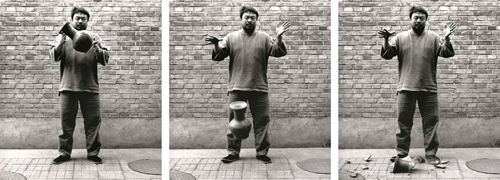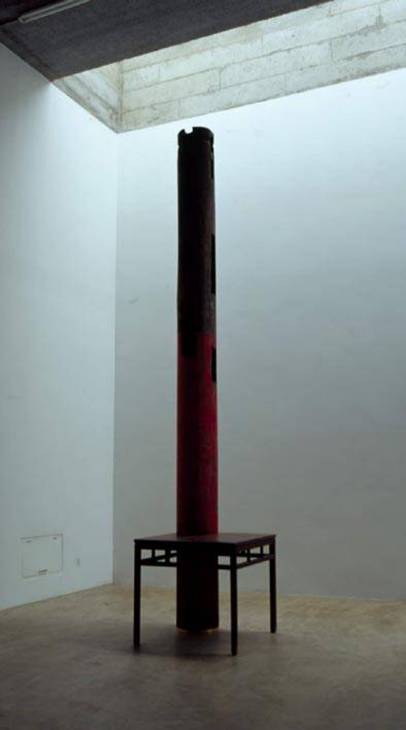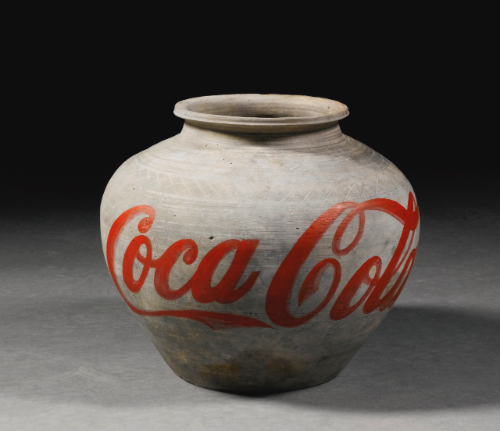Ai Weiwei has responded critically to China’s cultural traditions through his contemporary art starting with being one of the architects on the 2008 Beijing Olympic Stadium (Aloi 2007). Weiwei is a playful artist as described by a Cornell Professor, “Xiaowen Chen visiting associate professor of art at Cornell University. ‘But to me, his work is both a statement and playful event. He’s a troublemaker, but he never gets caught. His work shows us that anything goes, anything is possible,’” (Aloi 2007). Ai is playful in the way he challenges the systems around him. Ai took Western contemporary art themes and ideas and applied them to Chinese cultural artifacts. An example of this is a series of photographs of Weiwei dropping a centuries old urn and smashing it on the ground, physically destroying a Chinese artifact, a very modern and Western Approach to art. Ai Weiwei’s art is a legacy of the Chinese Communist Party (Sorace 2014). In the exhibition Ai Weiwei’s ideas regarding communists legacies and the Western industrialization process in China are explored. He comments on how China is being used as a center for Western industrial production and the ‘made in China’ phenomenon. Ai looks at capitalism through a communist lens and how it is destroying Chinese traditions. The images are displayed in an order that shows Ai’s communist ideals leading to issues of mass production and capitalism in China.

Dropping A Han Dynasty Urn
Artist: Ai Weiwei
Date: 1995
Dimensions: 148h x 121w cm each
Medium: Photography, Three gelatin silver prints
Displayed at Guggenheim Museum Bilbao
Description: This series of photographs show the progression of Ai dropping an ancient urn from the Han dynasty (206 BC-220 AD) and shattering it. Ai maintains the same facial expressions and stance throughout the series. This suggests that he is nonchalant about destroying what many would consider an important part of history and it is just another manufactured thing. The urn is the main subject in this photographed performance piece. This precious piece being shattered reflects China’s history being shattered. This replicates the Cultural Revolution’s destruction of religious artifacts to curb superstition (Sorace), a replication of a true communist act.

Tree
Artist: Ai Weiwei
Date: 2010
Dimensions: 6800 × 6500 × 6500 mm
Medium: Tree sections, metal bolts
Repository: Purchased with funds provided by Tate International Council, Tate Patrons and Yuz Foundation with support from Ai Weiwei 2016
Description: this artwork is made out of various pieces of bark from different species of trees from the Southern region of China. The viewer can see the different pieces of bark through the cuts and joints of the sculpture. This work can symbolize Taoist ideal of harmony – unifying the work of man with nature as well as linking the earth and the sky. This moves away from the industrial production in factories and the mass production of goods and shows how man should work with nature instead.

Table and Pillar
Artist: Ai Weiwei
Date: 2002
Dimensions: unconfirmed; approximately 4600 x 900 x 900 mm
Medium: Wood
Repository: Purchased with funds provided by the Asia Pacific Acquisitions Committee 2008, Tate Modern
Description: This work consists of a small square wooden table with a red pillar piercing through it. The pillar is not centered in the table but instead appears to be coming out of the top left corner of the table. The red paint on the pillar is scratched off in various places. This work goes against the industrial process in the way that this sculpture is made of damaged furniture and not new materials. The pillar stands tall coming out of the table to show that there is still strength in a non-industrial/consumer world.

Coca Cola Vase
Artist: Ai Weiwei
Date: 2011
Medium: Earthenware, paint
Sold at a Sotheby’s Auction in 2014
Description: This is a Han dynasty urn painted with the bright red Coca Cola logo. The brightness of the red logo juxtaposes the natural colors of the ancient urn. By painting a corporate logo onto a 2000 thousand year old vase, Ai draws attention to corporate mass production and shows how consumerism is changing Chinese history and culture and the way in which they produce goods. While Coca Cola is a Western brand it has taken over in China and become a very popular commodity showing that China is being used by Western corporations in a variety of ways.

Sunflower Seeds
Artist: Ai Weiwei
Date: 2010
Dimensions: variable
Medium: Porcelain
Exhibited at the Tate in 2010
Description: While these millions of sunflower seeds look like the real thing they are actually made of porcelain, a medium used in many traditional Chinese art pieces, such as vases or plates. These have been arranged in many different ways, such as a cone shaped mound or poured across an exhibition space like a sea to fill spaces at the Tate. These sunflower seeds were not industrially produced, commenting on the made in china phenomena and mass production of cheap goods.
Image Sources
Ai Weiwei. (1995a). Coca Cola Vase [Painted Ceramic]. Sotheby’s. http://www.sothebys.com/content/sothebys/en/auctions/ecatalogue/2014/contemporary-art-evening-auction-l14024/lot.56.html
Ai Weiwei. (1995b). Dropping a Han Dynasty Urn [Photograph]. Guggenheim Bilbao. https://www.guggenheim-bilbao.eus/en/learn/schools/teachers-guides/ai-weiwei-dropping-han-dynasty-urn-1995
Ai Weiwei. (2002). Table and Pillar [Sculpture]. Https://Www.Tate.Org.Uk/Art/Artworks/Ai-Table-and-Pillar-T12809. https://www.tate.org.uk/art/artworks/ai-table-and-pillar-t12809
Ai Weiwei. (2010a). Sunflower Seeds [Installation]. Tate. https://www.tate.org.uk/whats-on/tate-modern/exhibition/unilever-series/unilever-series-ai-weiwei-sunflower-seedsAi Weiwei. (2010b). Tree [Sculpture]. Tate. https://www.tate.org.uk/art/artworks/ai-tree-t14630
Text References
Ai Weiwei, dropping a Han dynasty urn, 1995: Guggenheim Museum Bilbao. Guggenheim Bilbao. (n.d.). Retrieved November 14, 2021, from https://www.guggenheim-bilbao.eus/en/learn/schools/teachers-guides/ai-weiwei-dropping-han-dynasty-urn-1995
Aloi, D. (2007). Ai weiwei: Smashing China’s Traditions in Art and Architecture. World Literature Today, 81(4), 42–43. http://www.jstor.org/stable/40159468
McQuaid, C. (2021, October 1). Icon or iconoclast? artist Ai Weiwei tangles with tradition at Springfield Museums – The Boston Globe. BostonGlobe.com. Retrieved October 11, 2021, fromhttps://www.bostonglobe.com/2021/09/23/arts/icon-or-iconoclast-artist-ai-weiwei-tangles-with-tradition-springfield-museums/.
MOONEY, P., & WEIWEI, A. (2012). CHATROOM: The Art of Dissent: A CHAT WITH AI WEIWEI. World Policy Journal, 29(3), 15–21. http://www.jstor.org/stable/23326803
Now contemporary art evening auction. ai weiwei coca cola vase ||| other ||| sotheby’s l14024lot7n9qyen. (n.d.). Retrieved December 6, 2021, from http://www.sothebys.com/content/sothebys/en/auctions/ecatalogue/2014/contemporary-art-evening-auction-l14024/lot.56.html.
Sorace, C. (2014). China’s Last Communist: Ai Weiwei. Critical Inquiry, 40(2), 396–419. https://doi.org/10.1086/674120
Tate. (1970, January 1). Ai Weiwei born 1957. Tate. Retrieved October 11, 2021, from https://www.tate.org.uk/art/artists/ai-weiwei-8208.
Tate. (1970, January 1). ‘sunflower seeds’, Ai Weiwei, 2010. Tate. Retrieved October 11, 2021, from https://www.tate.org.uk/art/artworks/ai-sunflower-seeds-t13408.
Tate. (1970, January 1). ‘table and Pillar’, Ai Weiwei, 2002. Tate. Retrieved October 11, 2021, from https://www.tate.org.uk/art/artworks/ai-table-and-pillar-t12809.
Tate. (1970, January 1). ‘tree’, Ai Weiwei, 2010. Tate. Retrieved October 11, 2021, from https://www.tate.org.uk/art/artworks/ai-tree-t14630.
Weiwei. (2014). Ai Weiwei: Spatial matters: Art architecture and activism.
Nice information. Thanks for sharing